POPULATION STUDIES
Paper – III
Note : This paper contains seventy five (75) objective type questions of two (2) marks each. All questions are compulsory.
Read the following passage and answer the questions below (1 to 4 ) :
Currently Japanese Economy & Society is undergoing profound changes in the demographic background caused by low fertility in the past. The most notable is the prospect that the population of Japan will soon be decreasing after the turn of the century. Population projections observed that population of Japan will reach its peak in the year 2015, and decrease thereafter. It would probably be the first experience in its history to have a continuous and longlasting loss of population by sustained below-replacement fertility.
Population in the working age group 15-64 had started declining since 1996. Another turning point in Japanese demographics occurred in 1997, when the elderly population aged 65 and over exceeded the child population aged under 15. The dependency ratio, a ratio of child and elderly population to working age population will also increase as a result of both the increase in the elderly population and the decrease in working population.
Population ageing also advances within each age group. This implies that unit costs of social security for the elderly population since older-elderly people are more expensive in terms of medical care. Population in the labour force are also rapidly ageing, presumably entailing such a consequence as decline in productivity and adaptability of the labour force as a whole.
1. Japanese economy and society is undergoing profound changes in the country’s population characteristics because of
(1) Declining working age population.
(2) Globalisation and trade competition.
(3) Internal political crisis.
(4) Relatively less immigration.
2. The overall dependency ratio is a ratio of
(1) Child population to working age population.
(2) Child population and elderly population to working age population.
(3) Elderly population to Child population.
(4) Elderly population to working age population.
3. Labour force ageing causes economic crisis as
(1) It reduces productivity and adaptability of the labour force.
(2) It increases disability among the workers.
(3) It reduces motivation to work hard.
(4) It increases their family responsibility.
4. Increase in the proportion of older-elderly would cause Japan to
(1) Withdraw all medical support for the older-elderly.
(2) Legalise euthenasia.
(3) Spend more on social security per elderly person.
(4) Encourage people to work in old age.
5. Which of the following is used as denominator to compute “under 5 mortality” ?
(1) Total live Births
(2) Population between 0-4
(3) Population between 1-4
(4) None of the above
6. Match the estimation methods in List-I with List-II and select the correct answer, using codes given below :


7. Which among the following cities has experienced a negative population growth rate between 2001 and 2011 census ?
(1) Kolkata
(2) Delhi
(3) Hyderabad
(4) Chennai
8. Which of the following state has highest percent of Scheduled Caste and Scheduled Tribe, combined population in India in 2011 census ?
(1) Odisha
(2) Jharkand
(3) Chhattisgarh
(4) Madhya Pradesh
9. Which among the following is defined as the physiological ability to conceive children ?
(1) Fertility
(2) Age specific fertility
(3) Fecundity
(4) total fertility
10. In India fertility reaches its peak, both in rural and urban areas, in which among the following age groups ?
(1) 15-19
(2) 20-24
(3) 25-29
(4) 30-34
11. Assertion (A) : Most settlers involved in agriculture, produce less agricultural output.
Reason (R) : Settlers lack information on better farming activities/techniques.
Codes :
(1) Both (A) and (R) are true, (R) is the correct explanation of (A).
(2) Both (A) and (R) are true, (R) is not the correct explanation of (A).
(3) (A) is true, (R) is false.
(4) (A) is false, (R) is true.
12. Which among the following statement is not correct ?
(1) Index of Contraception varies proportionally with the prevalence of contraceptive practices by couples in the reproductive age groups.
(2) Gross Reproduction Rate is the sum of Age specific fertility rates for female live births”.
(3) Effect of breast feeding on fertility was a factor in the framework developed by Davis and Blake (1956).
(4) Replacement level of fertility corresponds to the value of Net Reproduction Rate = 2.1.
13. According to SRS causes of death data in India 2010-2013, match cause of deaths in List-I with percent of deaths among female population of all ages in List-II.
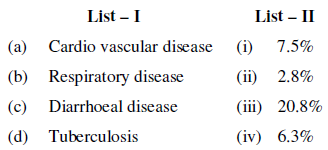
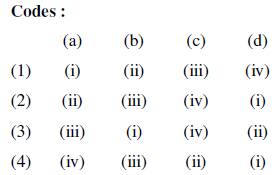
14. Which of the following state has the largest percent of Scheduled Caste population in India in 2011 census ?
(1) Punjab
(2) Himachal Pradesh
(3) West Bengal
(4) Haryana
15. Which one of the following interrelation among the life table function is not correct ?
(1) 
(2) ![]()
(3) ![]()
(4) ![]()
16. Which of the following indicators are taken to compute Physical Quality of Life Index (PQLI) ?
(a) Literacy Rate
(b) Life Expectancy
(c) Infant Mortality
(d) Per capital income
Codes :
(1) (a), (b), (c), (d)
(2) (a), (b), (c)
(3) (a), (c), (d)
(4) (a), (b), (d)
17. A country has currently a population of 100 million and having an annual growth rate of 3.5 percent. If the growth rate remains constant, what will be the population of this country in next 40 years (Approximate) ?
(1) 150 million
(2) 200 million
(3) 300 million
(4) 400 million
18. If all large states in India (Population 720 million) are grouped in four categories by their level of “Unmet need for Family Planning” in NFHS-3.

Then, which of the following is correct for the state of Chhattisgarh.
(1) Group I
(2) Group II
(3) Group III
(4) Group IV
19. Which one of the following has not been included in the intermediate variable framework by Davis and Blake.
(1) Intercourse variables
(2) Conception variables
(3) Contraception variables
(4) Gestation and Parturition variables
20. Census of India in its Migration table does not provide information on
(1) Immigration
(2) Emigration
(3) In migration
(4) Inter State migration
21. According to Rostow, which among the following propensities affect the pace of development.
(i) Propensity to develop Fundamental Sciences.
(ii) Propensity to apply Science to economic ends.
(iii) Propensity to accept innovations.
(iv) Propensity to seek material advancement.
Codes :
(1) (i) and (ii) are correct.
(2) (ii) and (iii) are correct.
(3) (iii) and (iv) are correct.
(4) (i), (ii), (iii) and (iv) are correct.
22. For which of the following level(s), the Expert Committee on Population Projections projects the population.
(1) National level only
(2) National and state level only
(3) National, State and district levels only
(4) State level only
23. The Government of India appointed the Health Survey and Development Committee (Popularly known as Bhore Committee) in which among the following years ?
(1) 1944
(2) 1946
(3) 1948
(4) 1950
24. Which among the following is not correct according to Lee’s laws of migration ?
(1) Volumes of migration
(2) Current and Counter Current migration
(3) Migration by stages
(4) Characteristics of migrants
25. Which of the following is not stated as a goal of health and family welfare sector for the 12th Five Year Plan (2012-17) in India.
(1) Reduction in IMR, MMR and TFR.
(2) Increase in contraceptive use.
(3) Reduction in anaemia among women 15-49 years.
(4) Raising Child Sex Ratio in ages 0-6 years.
26. Which one of the following index is used to measure the extent of preference for age ending with digit 0 and 5 ?
(1) Bogue’s Index
(2) Myer’s Index
(3) UN Age-Sex Accuracy Index
(4) Whipple’s Index
27. Which amongst the following is true about percent institutional deliveries in India (as per NFHS-3 report) ?
(1) Less than 25%
(2) 25 to upto 35 %
(3) 35 to upto 45%
(4) More than 45%
28. Arrange the following bigger states in descending order (high to low) in terms of infant morality rates according to the SRS Bulletin of September-2014.
(i) Odisha
(ii) Madhya Pradesh
(iii) Bihar
(iv) Haryana
Codes :
(1) (ii), (i), (iii), (iv)
(2) (iii), (iv), (i), (ii)
(3) (i), (iii), (ii), (iv)
(4) (i), (ii), (iii), (iv)
29. Who among the following proposed ‘The Big Push Approach’ in the area of Population and Development ?
(1) Arthur Levis
(2) Harrod-Domar
(3) Leibenstein
(4) Ricardo
30. Match the following Millennium Development goals numbers given in List-I with their goals given in the List-II below.

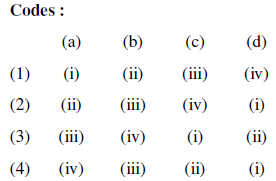
31. Assertion (A) : The Component method is a better method of population projections.
Reason (R) : It projects components of fertility, mortality and migration separately and then uses them to project population.
Codes :
(1) Both (A) and (R) are true, (R) is correct explanation of (A).
(2) Both (A) and (R) are true, (R) is not correct explanation of (A).
(3) (A) is true, (R) is false.
(4) (A) is false, (R) is true.
32. The place which attracts people from surrounding areas because of service availability is called
(1) Central Place
(2) Common Place
(3) Fringe Place
(4) Outer Place
33. Who among the following coined the term “expectation of life”.
(1) Edmund Halley
(2) George King
(3) Thomas R. Malthus
(4) Sir William Petty
34. Assertion (A) : Violence against women is a result of their subjugation.
Reason (R) : Uneducated women are subjugated and thus experience more violence.
Codes :
(1) (A) is true, (R) is true and (R) is correct explanation of (A).
(2) (A) is true, (R) is true and (R) is not correct explanation of (A).
(3) (A) is true, (R) is false.
(4) (A) is false, (R) is true.
35. Find out the combination of correct statements.
(a) In India, the family planning programme has played a major role in reducing fertility.
(b) Study of differential fertility helps in indentifying the lagging groups.
(c) Adolescent fertility is declining in both developed and developing countries.
(d) In china fertility has constantly declined since 1950.
Codes :
(1) (a) only
(2) (b) and (c)
(3) (a), (b) and (c)
(4) (a), (b), (c) and (d)
36. Which one of the following expressions, explains the low sex ratio (F/M) of child population in the age group 0-6 ?.
(1) Higher mortality of female children in the age 0-6 years.
(2) Lower coverage of female children in the census.
(3) Sex selective abortion where female foetus is aborted.
(4) All the three factors listed above.
37. Which of the following refers to Dispersed settlements ?
(1) Group of houses along a line.
(2) Scattered houses over large area.
(3) Group of houses along a nucleus.
(4) Very few houses clustered in one place.
38. According to the SRS Bulletin 2014, which expression describes correct level, high to low, of crude death rate among the following states.
(a) Kerala
(b) Karnataka
(c) Tamil Nadu
(d) Bihar
Codes :
(1) Bihar, Karnataka, Tamil Nadu, Kerala.
(2) Bihar, Karnataka, Kerala, Tamil Nadu.
(3) Tamil Nadu, Karnataka, Kerala, Bihar.
(4) Kerala, Tamil Nadu, Karnataka, Bihar.
39. Assertion (A) : Total Marital Fertility Rate (TMFR) is a more refined indicator of fertility than Total Fertility Rate (TFR).
Reason (R) : TMFR takes into consideration marital status of women in different Reproductive age groups.
Codes :
(1) Both (A) and (R) are true, (R) is the correct explanation of (A).
(2) Both (A) and (R) are true, (R) is not the correct explanation of (A).
(3) (A) is true, (R) is false.
(4) (A) is false, (R) is true.
40. Which among the following is considered to develop Gender-related Development Index (GDI) ?
(A) Gender gap in health.
(B) Gender gap in knowledge.
(C) Gender gap in mobility.
(D) Gender gap in living standard.
Codes :
(1) Only (A), (B) and (C)
(2) Only (B), (C) and (D)
(3) Only (A), (B) and (D)
(4) Only (A), (C) and (D)
41. If the population in the beginning of age x is Px and in the beginning of age x + 1 as Px + 1 and number of deaths in the age x to x + 1 is dx, then risk of death in the age x to x + 1 is computed by using which of the following denominators.
(1) Px
(2) Px + 1
(3) 
(4) None of the above
42. Assertion (A) : Population projection of Japan has shown that Japan would experience population decline around the year 2015.
Reasoning (R) : Japan has experienced sustained below replacement level fertility.
Codes :
(1) (A) is true, (R) is true, (R) is correct explanation of (A).
(2) (A) is true, (R) is true, (R) is not correct explanation of (A).
(3) (A) is true, (R) is false.
(4) (A) is false, (R) is true.
43. According to the 2011 census, which one of the following expression arranges most populous states in India, from high to low.
(1) U.P., Bihar, Maharashtra, West Bengal.
(2) U.P.. Maharashtra, Bihar, West Bengal.
(3) U.P., Maharashtra, West Bengal, Bihar.
(4) U.P., Maharashtra, Bihar, Karnataka.
44. Who among the following has focussed on Intervening opportunities between place of origin and place of destination ?
(1) Stouffer’s Model of Migration
(2) Todaro’s Model of Migration
(3) Ravenstein’s law of Migration.
(4) Lee theory of Migration.
45. Which of the following combination of data are required to compute Net Reproduction Rate ?
(a) Age specific birth rates
(b) Percent female births
(c) Female population by age
(d) Probability of survival of girls from birth to reproductive age
Codes :
(1) (a), (b), (c), (d)
(2) (a), (b), (d)
(3) (b), (c), (d)
(4) (a), (c), (d)
46. Which among the following theory states that benefits of fast economic growth will seep through the high-income groups to all lower income sections of society ?
(1) Malthus theory
(2) Demographic transition theory
(3) Trickle down theory
(4) Health transition theory
47. If the number of infant deaths in year ‘y’ is D′y and the number of infant deaths in year ‘y+1′ is D″y+1 occurred to the births in year ‘y’ is By. Which one of the formula is correct to calculate adjusted infant mortality rate ?
(1) 
(2) 
(3) 
(4) 
48. Which of the following decades showed decline in the rate of population growth, first time, in India ?
(1) 1961 – 1971
(2) 1971 – 1981
(3) 1981 – 1991
(4) 1991 – 2001
49. Which one of the following is the top-most (Rank – I) cause of deaths in the EAG states and Assam, according to SRS cause of deaths in Indian Report 2010-2013;
(1) Respiratory diseases
(2) Tuberculosis diseases
(3) Cardiovascular diseases
(4) Digestive diseases
50. Which one of the following is not a included in the construction of ‘Human Development Index (HDI)’ ?
(1) Adult literacy
(2) Expectation of life at birth
(3) Per capita income
(4) Adult sex ratio
51. Which among the following is not a measure of population Ageing ?
(1) ageing of elderly population.
(2) ageing index.
(3) child-age dependency ratio.
(4) median age of the population.
52. Match the name of the scholars in List-I with the concepts they are associated with in the List-II given below :

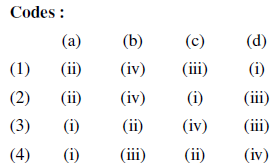
53. Match names of the authors of the books given in List-I with names of the books given in List-II :

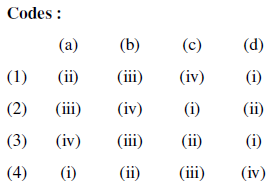
54. Which among the following does not include in the Everett Lee’s conceptual frame work for migration analysis ?
(i) Factors associated with the area of origin.
(ii) Factors associated with the area of destination.
(iii) Intervening obstacles.
(iv) Personal factors.
Codes :
(1) (i)
(2) (i), (ii)
(3) (i), (ii), (iii)
(4) (i), (ii), (iii) & (iv)
55. Which among the following formula is used for calculating expectation of life at birth ![]()
(1) 
(2) 
(3) 
(4) 
56. A country currently has a population of 100 million and an annual growth rate of 3.5 percent. If growth rate remains constant, how many years it takes to double is population ?
(1) 15 years
(2) 20 years
(3) 25 years
(4) 30 years
57. Match the following items in List-I with those given in List-II.

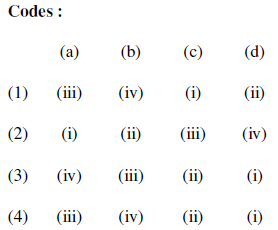
59. Match the items in List-I with List-II.

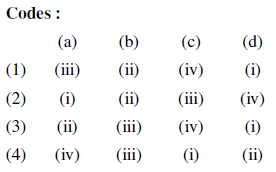
60. Match the items in List-I with List-II and select the correct answer using codes given below.
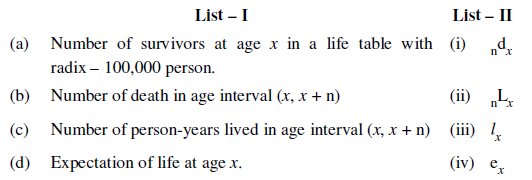
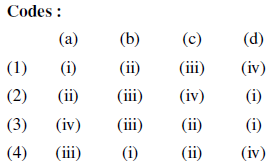
61. Which one of the following is correctly defined as old age dependency ratio ?
(1) Young population under 15 years of age to elderly population in 60+ age group.
(2) Elderly population in 60+ age group to population in 15-59 years of age.
(3) Population in 15-59 years of age to elderly population in 60+ age group.
(4) Elderly population in 60+ age group to young population in under 15 years of age.
62. Match the following items in List-I with those in List-II.

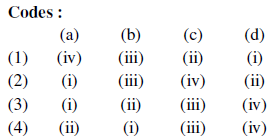
63. Neo-classical micro-economic theories of migration emphasize on which of the following ?
(1) Labour market
(2) Marriage market
(3) Household and individual choice
(4) Multiple market together
64. Which among the following is Direct Anti natalist policy ?
(1) Reducing infant and child mortality.
(2) Raising age at marriage.
(3) Raising income of the families.
(4) Women’s employment and status.
65. Match items given in List-I with the items given in List-II related to the National Family Health Survey-4 given below :
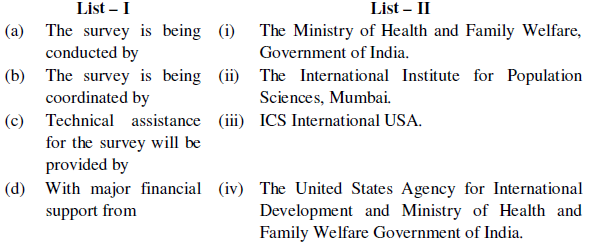

66. Assertion (A) : About 19 percent of young women in developing countries become pregnant before age 18 years (UNFPA, 2013).
Reason (R) : Young women more often face descrimation, social exclusion, poverty, marginalization and gender inequality limiting their access to health care.
Codes :
(1) (A) is true, (R) is true, (R) may be one of the explanation of (A).
(2) (A) is true, (R) is true, (R) is not correct explanation of (A).
(3) (A) is true, (R) is false.
(4) (A) is false, (R) is true.
67. Match the following items in List-I with List-II.
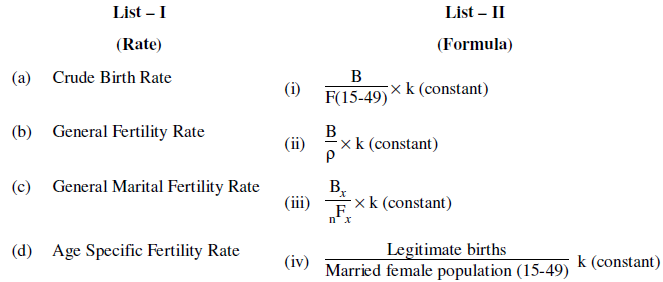
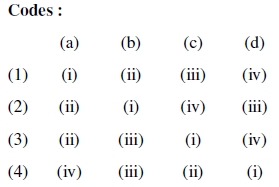
68. Which among the following is optimum birth weight of child survival in India ?
(1) 2000 gms to 2500 gms
(2) 2500 gms to 3000 gms
(3) 1500 gms to 2000 gms
(4) 3000 gms to 3500 gms
69. In life table, the survival ratio can be obtained by
(1) 
(2) 
(3) 
(4) 
70. Which one of the following formula used to calculate adjusted CDR by direct standardized method. Considering PR as reference population and PS as standard population ?
(1) 
(2) 
(3) 
(4) 
71. Which of the following disease has been the focus of World Health Day on 7th April 2016 ?
(1) Hypertension
(2) Diabetes
(3) Osteoporosis
(4) Malaria
72. Match List-I (Name of the theories) with List-II (names of the person associated with the theories) given below.

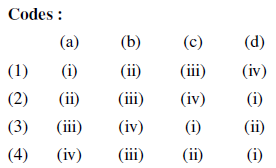
73. Which one of the following statements is true for the demographic transition stage-III ?
(1) High birth rates, high death rates, and low growth rates.
(2) High birth rates, declining death rates, and rising growth-rates.
(3) Continued decline of death rates, declining birth rates, growth rate decline from high to lower levels.
(4) Low birth-rates, low death rates, and low growth rates.
74. Assertion (A) : Crude death rate of India and USA cannot be used to compare level of mortality in two countries.
Reason (R) : Crude death rate in affected by variables extraneous to mortality.
Codes :
(1) (A) is correct, (R) is correct and explains (A) correctly.
(2) (A) is correct, (R) is correct and does not explain (A).
(3) (A) is correct, (R) is incorrect.
(4) (A) is incorrect, (R) is correct.
75. Which one of the following methods is not used for fertility estimation ?
(1) Rele’s Method
(2) Own Children Method
(3) National Growth Rate Method
(4) Stable Population Method
Latest Govt Job & Exam Updates: